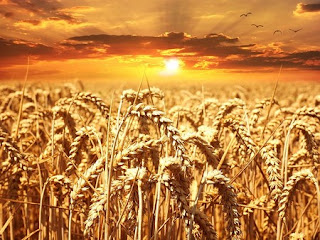The drought continues in parts of the United States and wheat and other agriculture products continue to rise in price. Whether it's too little rain or too much rain at the wrong time, agriculture prices will always fluctuate. You can profit from the fluctuations with ETFs.
You can trade wheat and other agriculture commodities in the futures market. That is a more complicated way to trade in wheat and takes knowledge of the commodities and futures market. This article will talk about more common ways to invest in wheat and other agriculture products.
This market is not for the person looking for safe or risk-free investments. December wheat had a gain of 17.5% at the start of trade last Friday, August 6, but lost 7.4% for the day. Wheat still had a gain of 8.9% for the week. Even though this information is just for one recent week, it shows how the prices can move.
The reason that wheat dropped last week was because traders started to believe that more farmers would plant more wheat in response to the recent rise in price, causing a drop in future prices. You can watch the daily price of wheat at Bloomberg.com.
Invest in Wheat and Agriculture ETFs and ETNs
The ETF (exchange traded fund) and ETN (exchange traded note) market has really grown in the past decade, with ETFs covering almost everything. And there are ETFs to trade in the rising prices of wheat and other agriculture commodities. Here are some of these ETFs and ETNs you can trade or invest in for rising wheat and agriculture prices.
Keep in mind, the percentage of wheat or other agriculture futures in each ETF can change over time. At some time, one will have more soybean futures than wheat for example.
- PowerShares DB Agriculture (DBA). This ETF holds futures contracts on wheat, corn, soybeans and sugar.
- iPath Dow Jones UBS Grains Total Return (JJG) is composed of wheat, soybeans and corn and follows the performance of these grains. JJG is probably the closest to trading or investing in wheat you can get without actually buying wheat futures.
- ELEMENTS MLCX Grains Index (GRU). This ETN tracks the performance of futures contracts of wheat, soybeans, soy meal and corn.
- Elements Rogers Intl Commodity Agriculture (RJA), this ETN attempts to replicate the Rogers International Commodity Index – Agriculture Total Return index. This index represents the value of a basket of 20 agricultural commodity futures contracts.
- iPath Dow Jones UBS Agriculture Total Return Sub-index (JJA). This ETN has seven agriculture futures contracts; wheat, corn, soybeans, cotton, soybean oil, coffee and sugar.
- Market Vectors Agribusiness (MOO): This ETF invests in stocks of US and foreign companies that derive at least 50% of their revenues from agriculture business.
Something else you should look at with these is their trading volume. A low trading volume could make the price more volatile. Of this list, DBA and MOO have the highest average daily volume followed by RJA, JJG and GRU.
Agriculture Stocks
If you would rather invest in the companies that sell agriculture equipment, seeds or fertilizer, you can buy those stocks.
- John Deere (DE). Most people know Deere as the company that sells farm equipment like tractors but they also provide agriculture with combines and other harvesting equipment, seeding equipment, sprayers and even agriculture software.
- Bunge (BG), which sells fertilizer to North and South America among other agribusiness related products.
- Potash (POT) is a large company that sells fertilizer and recently reported a very good quarterly profit.
- Mosaic (MOS) is another large seller of fertilizer and other agriculture products.
To look at more companies involved in agriculture, you can look at the S&P Agribusiness North America Index, which is comprised of 24 of the largest agriculture related companies.
Profit from Dropping Wheat and Agriculture Prices
Now that wheat has risen 90% in the past several months and the news is widespread about the Russian drought and wildfires, the price could start to drop. You can still make money with wheat or other agriculture prices falling.
I do not recommend shorting stocks or ETFs unless you are a seasoned trader since shorting can be very risky.
You can buy put options on DBA, which will give you a profit if DBA drops in price. There are also ETFs that you can buy that are shorting ETFs; they do the shorting for you. Make sure you understand leveraged and double short ETFs before you put your money into these. The ETFs you can buy when you expect a drop in wheat and the other food items are:
- DB Agriculture Short ETN (AGA); is comprised of equal percentages of wheat, corn, soybeans and sugar.
- Short Wheat Exchange Traded Commodity (SWEA) is traded on the London Stock Exchange will change the opposite of the daily price of wheat.
For more about commodity inverse ETFs, please read How to Profit from Falling Commodity Prices.
Conclusion
Before you invest or trade in any of these financial instruments, make sure you completely understand them and the markets they represent.


No comments:
Post a Comment